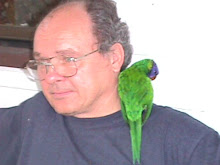Wednesday, April 4, 2012
A Matter of Grey
Saturday, March 17, 2012

We experienced the latter on Saturday [17 March]. Not that we were birding avidly at the time. Far from it. There were too many tasks around the Allen Road property listed as needing urgent attention to allow for any serious birding. Nevertheless, as a matter of habit, even while filling in another deepening rut [clay soil and heavy rainfall make for sloppy track surfaces that rapidly degenerate into seeming chasms] eyes and ears remained alert to the possibility of new, or at least interesting, birds passing by.
Fay called me out on the second call of the Glossy Black-Cockatoo Calyptorhynchus lathami.
You need to understand that unlike its near local relatives, the more common Yellow-tailed C. funereus and the rarer Red-tailed Black-Cockatoo C. banksii, both raucous variants of the family, the Glossy [actually a brown rather than a black cockatoo] is a comparatively quiet bird. Its call could go undetected; its arrival unnoticed as it locates a suitable tree to silently chew away on seed pods.
We both ceased whatever it was we were engaged in doing at the time, grabbed our binoculars [never too far from hand], raced down the front steps and cautiously approached what we refer to as the “Northwest Quadrant” of the property [not that the property is actually divided into four equal parts, nor indeed are there four definable segments]. Fay had heard the bird call from this section; our last sighting of it had been here.
But it was always going to be exciting! As I have written elsewhere, they remain the darlings of our backyard bird species.
Glossy Black-Cockatoo
Sunday, February 19, 2012
Over the Summer Hump


Finally we touch upon one of mine and Fay’s favourite summer migrants, the Sacred Kingfisher Todiramphus sanctus. We almost thought that it had deserted us this season: last year it nested in the tree right on the southern boundary fence of the property; in earlier years it has nested in the old ironbark within ten metres of the house. However, it was simply a matter of seeking out its new location, in the northeast quadrant.
Tuesday, January 3, 2012
NEIGHBOURLY SURPRISES
Nevertheless, throughout, birding along Allen Road has continued where circumstances permitted, with the unexpected arrival of a Black-eared Cuckoo Chalcites osculans as one of the season’s highlights.
 Photograph by Graeme Chapman. http://graemechapman.com.au
Photograph by Graeme Chapman. http://graemechapman.com.au
Frustratingly, while we have heard it call from all points of the compass around the property all our efforts to actually locate the bird, with the exception of one fleeting view as the bird raced away, have proved fruitless.
We console ourselves with the knowledge that the same was true of its relative, the Brush Cuckoo Cacomantis variolosus which, in a similar manner, eluded our binoculars for months. Then, on Thursday 29 December 2011, during one of our customary early morning walks along Allen Road, we spotted the bird calling from a smallish tree to our left. The walk was suspended for a few moments while we savoured the view. Photograph by Ian Montgomery. birdway.com.au
Photograph by Ian Montgomery. birdway.com.au
That’s all part and parcel of birding along Allen Road. On a daily basis you see and/or hear the regular residents, the Torresian Crows Corvus orru and Noisy Miners Manorina melanocephala, the Australian Magpies Cracticus tibicen and Striped Honeyeaters Plectorhyncha lanceolata but every now and then you come across the more unusual – the Australasian Bittern Botaurus poiciloptilus [4 November 2001] flying over your head, the Black-faced Monarch Monarcha melanopsis [new to the Backyard List in December 2011],
Similarly, summer has its regulars. The Sacred Kingfisher Todiramphus sancta and Channel-billed Cuckoo Scythrops novaehollandiae, the Little Friarbird Philemon citreogularis and Olive-backed Oriole Oriolus sagittatus but again, there can be the unexpected – the Rainbow Bee-eater Merops ornatus and Australasian Figbird Sphecotheres vielloti which comes, remains a day or two and disappears to occasionally put in a rare repeat visit in the one season.
And then of course there are always the part-time birding neighbours who simply floor you with a totally unexpected revelation.
It was back in July 2009 that Les, an ex-Vietnam Veteran two blocks away, first informed us of the aberrant flock of Budgerigars Melopsittacus undulatus he’d noted along Allen Road a number of years earlier By the time he appreciated that Fay and I were more than simply interested, more akin to obsessed, he could recall few further details. The report is duly entered in our computer records in the hope that the birds return to Allen Road one day.
We were in for an even greater surprise during the last weeks of 2011 when we walked over to our neighbours, Denis & Jeanette, both avid backyard bird feeders with a tabletop fieldguide but who play little part in active birding. It was the evidence of the photographs that stunned us.
The Rose-ringed Parakeet Psittacula krameri, clearly an escapee and therefore probably failing to meet the “viable population” criterion, had, on and off, been visiting their backyard birdtable for the past two or three years. Jeanette photographed it on one of those occasions. Its continued presence over that period leaves many unanswered questions.
 Photograph by Jeanette McBryde.
Photograph by Jeanette McBryde. Photograph by Jeanette McBryde.
Photograph by Jeanette McBryde.

